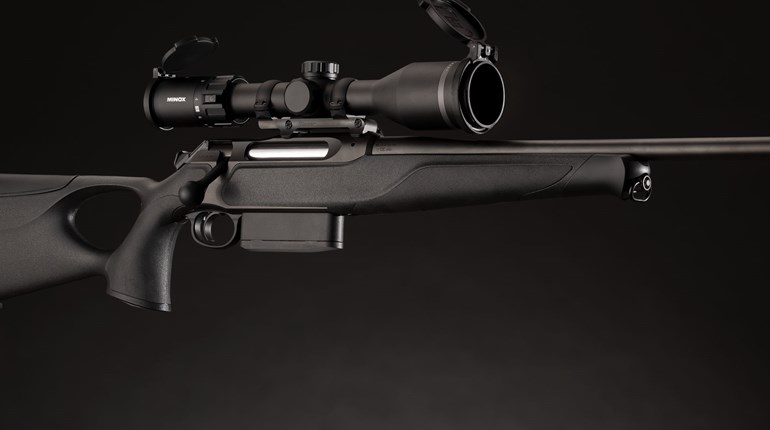
The below is an excerpt from the 1978 book, Olympic Shooting, written by Col. Jim Crossman and published by the NRA. Read Part 1.
1912—Stockholm: The Games Become An Event (Part 2)
By Colonel Jim Crossman
The 300-meter individual match with the army rifle was something new. Starting with the shooter in a standing position, the butt of the rifle on the ground and the rifle open, the shooter had three minutes to load, get into position and fire 4 shots from the prone position, 4 shots from the kneeling position and 2 shots standing. The target had circular rings, the 5-ring less than 20 inches across. The second stage of the match started in a similar way, and the shooter had three minutes to fire 5 shots prone and 5 shots kneeling at a half-figure silhouette.
The pistol duel-shooting had not been included in the 1908 Games although competitive duel-shooting was fairly popular in parts of Europe. The figure was man-sized, with scoring rings superimposed on it. The rings were used only for settling ties, with number of hits counting as first importance. This was a surprise-fire target, with the target appearing for three seconds and disappearing for five seconds. The shooter had to drop his arm to a 45-degree downward position between shots.
The clay pigeon match was unlike the game shot in the United States in a number of respects. There were five firing points in a straight line, five yards apart and 15 meters from the trap. In front of each firing point was a group of three traps. Each trap was set to throw at a different angle. The shooter at any firing station knew he would get a bird from one of the traps in front of him, but he did not know which one and therefore did not know what the angle would be.
The bird was thrown considerably farther than the U.S. bird and was faster and harder to hit. The shooter could fire two shots at the bird and it did not matter if he used one or two shots, just as long as he broke the bird. So far, this is much like the same event shot in 1908 and nearly the same as present-day international and Olympic trapshooting.
But the Swedes threw in one hooker that caused some concern. The shooter could not have the gun at his shoulder when the bird appeared. This was a change from 1908, which permitted the gun to be held at the shoulder. "Any position" is the rule now in effect. In addition to series of shots in the continuous-fire, known traps, unknown angles system, there were also series fired at birds thrown in the unknown trap, unknown angle method.
The continuous-fire system was much like trapshooting today, with each member of a squad firing in turn from each of the five stations. In each case, one of the three traps in front of that station would throw the bird. But in the unknown trap, unknown angle stage, the shooter stood at the middle shooting station and he could be thrown a bird from any one of the 15 traps. Strange as all this was to the American shotgun shooter, he decided to do something different this year also. He organized and entered a team for the trapshooting events.
At this time there was no trapshooting organization like the rifle shooter's National Rifle Association or the handgunner's United States Revolver Association (USRA). Trapshooting was in the hands of the Interstate Association, which had originally been called the Interstate Manufacturers and Dealers Association. It was organized, controlled and financed by the shooting industry, rather than by the shooters themselves as in rifle and pistol shooting.
Although the record is not clear as to the details, it seems most likely that the trapshooting squad was picked and financed by the Interstate Association.
The fine U.S. trapshooting squad of 1912, marking the first U.S. Olympic trapshooting entry, was comprised of:
- Charles W. Billings, Glen Ridge, N.J.
- Ralph L. Spotts, New York, N.Y.
- John H. Hendrickson, New York, N.Y.
- James R. Graham, Ingleside, Ill.
- Dr. Edward F. Gleason, Boston, Mass.
- Frank Hall, Ridgefield Park, N.J.
- Daniel F. McMahon
The year 1912 was a busy one for the NRA. In addition to the Olympics, an international Pan-American Match was scheduled in Argentina, a Palma Match was arranged with the Canadians and the International Shooting Union championships were to be fired in France (the National Rifle Association having joined the International Shooting Union some years previously). The National Rifle Association decided to pass up the UIT matches in favor of the others. But the Ohio State Rifle Association sent a team to France. Unfortunately, and to the Ohio shooters' dismay, the other countries objected to the sling and peep sights which were standard in U.S. shooting.
The NRA final tryouts for the Olympic team were held at the Marine Corps base near Winthrop, Md. Cmdr. Harris Laning, rifle team captain, had decided the team should train before going overseas. Shooting under the Olympic conditions and on the Olympic targets, the team trained hard for about three weeks. In addition to the shooters for the big team match, Laning asked Capt. Edwin L. Anderson of Alabama to give a hand with the smallbore rifle team, while 1908 Olympic team member W.F. Leushner was asked to help with smallbore rifle and the running deer training. Walter Winans, over in England, agreed to help out and was selected captain of the running deer squad. Lt. Col. William Libbey, New Jersey National Guard and one of the well-known men in rifle shooting circles, was chosen as the team adjutant. W. Neill McDonell was chosen as team surgeon. Other members of the U.S. rifle squad were:
- Sgt. Harry L. Adams, U.S. Cavalry
- Capt. Allan L. Briggs, U.S. Infantry
- Capt. Cornelius L. Burdette, National Guard of West Virginia
- Capt. Fred S. Hird, National Guard of Iowa
- Sgt. Joseph E. Jackson, National Guard of Iowa
- Lt. Carl T. Osburn, U.S. Navy
- Hospital Steward Warren A. Sprout, U.S. Navy
- Ens. Harold T. Bartlett, U.S. Navy
The riflemen were joined by the pistol shooters who had been selected by the U.S. Revolver Association:
- Reginald H. Sayre, New York, N.Y. Team Captain
- John A. Dietz, New York, N.Y.
- Peter J. Dolfen, Springfield, Mass.
- Alfred P. Lane, New York, N.Y.
- Henry E. Sears, Boston, Mass.
- Hans Roedder
- Walter Winans, living in England, joined the team in Sweden.
This was a powerful handgun team, with Sayre, Dietz and Winans having shot on the 1908 team. The other members were experienced shots also. Lane had won several USRA championships the year before, while Roedder was just reaching his peak. He went on to win three USRA championships in succeeding years.
The American Olympic Committee had chartered the SS Finland, both to provide transportation and to serve as a floating hotel in Sweden. The shooters took the 10-day trip from New York to Antwerp, but had to leave the ship there on the 24th to go directly by train to Stockholm, since the shooting events started on the 29th, prior to the main big Olympic week. At first the team despaired of making it in time, as the group of 21 seemed to be too large for the European railroads to handle. For example, it took six hours for the ticket agent to prepare the tickets. But early on the morning of the 26th, the team arrived in Stockholm, eager and anxious to get at the ranges.

Photo: Members of the 1912 U.S. Olympic Pistol Team (l. to r.) Alfred P. Lane, Henry E. Sears, Peter J. Dolfen and John A. Dietz. Photo taken from the official report of the Stockholm 1912 Summer Olympic Games. The photographer is unknown.
Part 3 of our retrospective on the Stockholm 1912 Olympic Games is coming soon. Subscribe to the free Insider newsletter for the latest updates.
Read more: The Origin Of The Olympic Games



































